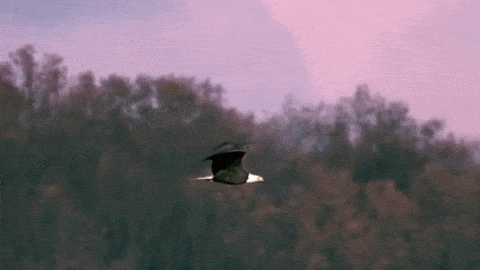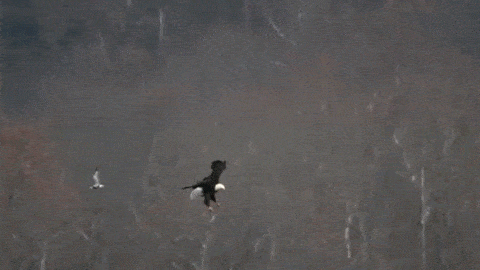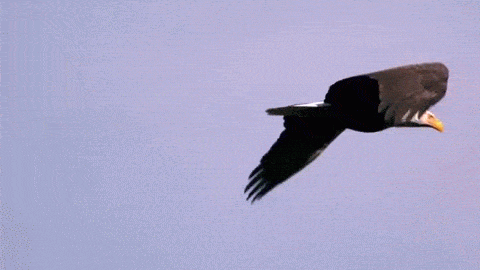All Native North American Peoples attach special significance to the eagle, and its feathers.
The eagle flies higher and sees well than any other bird. Its perspective is therefore different from those of us held close to the earth.
1- Among the Pueblo tribes, eagles are considered one of the six directional guardians, associated with the upward direction, spirituality, and balance. The Zunis carve stone eagle fetishes for protection, ascribing to them both healing and hunting powers, and the Eagle Dance is one of the most important traditional dances held by the Hopi and other Pueblo tribes.
2- In the mythology of some tribes, Eagle plays a leadership role (either as king of the birds, or as a chief who humans interact with.) In other legends, Eagle serves as a messenger between humans and the Creator. The golden eagle, also known as the "war eagle," is particularly associated with warriors and courage in battle, and it is golden eagle feathers that were earned by Plains Indian men as war honors and worn in their feather headdresses. (In some tribes, this practice continues to this day, and eagle feathers are still given to soldiers returning from war or people who have achieved a great accomplishment.)
3- In some Northwest Coast tribes, the floor used to be dusted with eagle down at potlatches and other ceremonies as a symbol of peace and hospitality.
4-Because eagles are considered such a powerful medicine animal, the hunting or killing of eagles was restricted by many taboos. Eating eagle meat was forbidden in many tribes; in some legends, a person who eats eagle meat is transformed into a monster.
5- In some Plains Indian tribes, feathers were required to be plucked from a live eagle so as to avoid killing them (to accomplish this, eagles were trapped in a net and released.) In Southeastern tribes, only men with special eagle medicine, known as Eagle-Killers were permitted to kill eagles. In the Cherokee tribe, even Eagle-Killers were only permitted to kill eagles during wintertime.
6- Eagles are also one of the most widespread clan animals used by Native American cultures. Tribes with Eagle Clans include the Chippewa (whose Bald Eagle Clan and its totem are called Migizi, while the Golden Eagle Clan is called Giniw), the Hopi (whose Eagle Clan is called Kwaangyam or Qua-wungwa), the Zuni (whose Eagle Clan name is K'yak'yali-kwe) and other Pueblo tribes of New Mexico, Plains tribes like the Caddo and Osage, and Northwest Coast tribes like the Haida, Kwakiutl, Tsimshian, and Tlingit. Eagle was an important clan crest on the Northwest Coast, and eagle designs can often be found carved on totem poles, ceremonial staffs, and other traditional Northwestern art. And many eastern tribes, such as the Cherokee, have an Eagle Dance among their tribal dance traditions.
7- You cannot take an eagle feather without offering tobacco
8- Eagle feathers are sacred, and only given under special circumstances. It is a great honor to have the right to wear eagle feathers. They are not given lightly.
The eagle flies higher and sees well than any other bird. Its perspective is therefore different from those of us held close to the earth.
1- Among the Pueblo tribes, eagles are considered one of the six directional guardians, associated with the upward direction, spirituality, and balance. The Zunis carve stone eagle fetishes for protection, ascribing to them both healing and hunting powers, and the Eagle Dance is one of the most important traditional dances held by the Hopi and other Pueblo tribes.
2- In the mythology of some tribes, Eagle plays a leadership role (either as king of the birds, or as a chief who humans interact with.) In other legends, Eagle serves as a messenger between humans and the Creator. The golden eagle, also known as the "war eagle," is particularly associated with warriors and courage in battle, and it is golden eagle feathers that were earned by Plains Indian men as war honors and worn in their feather headdresses. (In some tribes, this practice continues to this day, and eagle feathers are still given to soldiers returning from war or people who have achieved a great accomplishment.)
3- In some Northwest Coast tribes, the floor used to be dusted with eagle down at potlatches and other ceremonies as a symbol of peace and hospitality.
4-Because eagles are considered such a powerful medicine animal, the hunting or killing of eagles was restricted by many taboos. Eating eagle meat was forbidden in many tribes; in some legends, a person who eats eagle meat is transformed into a monster.
5- In some Plains Indian tribes, feathers were required to be plucked from a live eagle so as to avoid killing them (to accomplish this, eagles were trapped in a net and released.) In Southeastern tribes, only men with special eagle medicine, known as Eagle-Killers were permitted to kill eagles. In the Cherokee tribe, even Eagle-Killers were only permitted to kill eagles during wintertime.
6- Eagles are also one of the most widespread clan animals used by Native American cultures. Tribes with Eagle Clans include the Chippewa (whose Bald Eagle Clan and its totem are called Migizi, while the Golden Eagle Clan is called Giniw), the Hopi (whose Eagle Clan is called Kwaangyam or Qua-wungwa), the Zuni (whose Eagle Clan name is K'yak'yali-kwe) and other Pueblo tribes of New Mexico, Plains tribes like the Caddo and Osage, and Northwest Coast tribes like the Haida, Kwakiutl, Tsimshian, and Tlingit. Eagle was an important clan crest on the Northwest Coast, and eagle designs can often be found carved on totem poles, ceremonial staffs, and other traditional Northwestern art. And many eastern tribes, such as the Cherokee, have an Eagle Dance among their tribal dance traditions.
7- You cannot take an eagle feather without offering tobacco
8- Eagle feathers are sacred, and only given under special circumstances. It is a great honor to have the right to wear eagle feathers. They are not given lightly.







Mike Jock Akwesasne comes to mind
At 56 I'm a senior at Purdue majoring in Film and Video. What I do best is write, so with luck this degree will open doors that can highlight that talent. I'm writing to ask where I can find the best resource for Native American mythologies, all inclusive. I have two Native American characters in two film ideas that I want to know as much about as I know about myself before I begin to get serious about doing the scripts. Also, for one I have chosen the Hopi name Mansi, my understanding is that it means "plucked flower", and as she would have lived a couple of thousand years ago, so if there's anything more specific to that time period that I could be accurate with and would also help me know more of what I need, and also want, to know.
Any referrals or assistance with this would be greatly appreciated as I'm not going to let myself expand on her part until I know, literally, everything about everything about her. I've read "Water Lily" and all the course materials and then some for my Native American Anthropology class, and I'm anxious to find anything that could help me further this effort. Thank you for your time and careful consideration Michael K Walker
Michael, I wish you success in your endeavors, by bringing the stories of the original people to the rest of us you enrich all of us. Consider this though as you go... the founders of our nation were greatly effected by the original people, they did not "come up with the Articles of Confederation out of a vacuum, it came from the Iroquois Nations. And... I think that the peoples of the Pacific Northwest have some of the best stories to tell and some great mythical beings. The Yurok and Karuk People are very good storytellers and they might be interested in telling some of their stories to you. My favorites are Raven stories. Good luck,
http://www.yuroktribe.org/departments/education/Yurok_Tribe_Language_Program/
http://www.ihs.gov/california/index.cfm/about-us/contact-us/
Thank you very much, the links will be useful as will the advice. The character I intend to create would have to be from the Original People for her character to to be real to me and for the story to work. Moreover it's paramount to me that I base everything about her on known histories and mythologies given the extent of the role she will play.
This gives me a great jumping off point in getting to know her, so again, thank you...
I remember my experience with an eagle. I was at Ft. Jackson and an eagle landed fifty feet away from me. It just stood there for a second, then started walking. The most beautiful thing I ever saw.
Recently I saw a bald eagle fly low over my yard , in a city,. It flew lower then the roof of my 2 story house. Ihave seen an eagle several times repeat this. So now what is the idea here ?